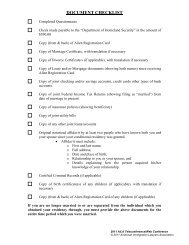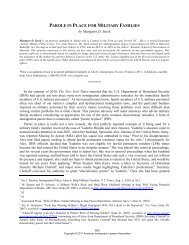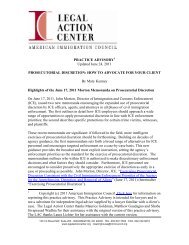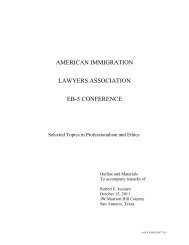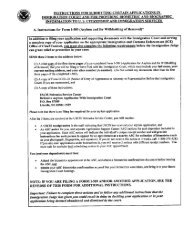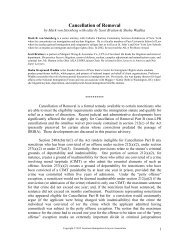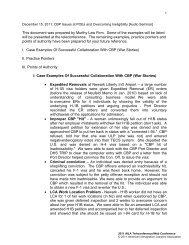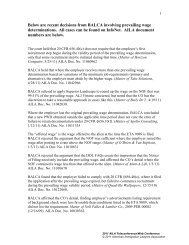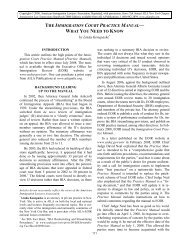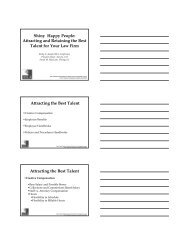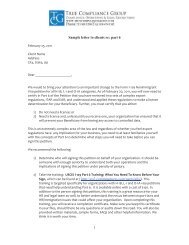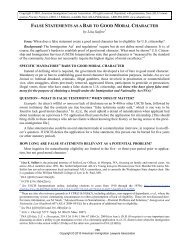Resources for 04-26-11 Seminar - AILA webCLE
Resources for 04-26-11 Seminar - AILA webCLE
Resources for 04-26-11 Seminar - AILA webCLE
Create successful ePaper yourself
Turn your PDF publications into a flip-book with our unique Google optimized e-Paper software.
WAC 10 08150986Page 10provided copies of business correspondence between the petitioner's commissioned sales managers, itsmaterial engineer, and its auto industry customers. The record indicates that the petitioner is not merelyselling a standard, stock product but rather is working with automobile company engineering staff and thepetitioning group's engineering staff in order to custom design and manufacture parts <strong>for</strong> use in commercialand passengcr cars sold by U.S. automakers. The documents exchanged during the quotation process aredetailed engineering and manufacturing design documents. As established by the evidence, the processrequires the petitioner's staff to meet with the U.S. customers' staff to discuss product specifications andwould reasonably require the services of individuals who have engineering or related degrees themselves.Given the nature ofthe work, the AAO finds sufficient evidence in the record to support a finding that at leasta majority of the U.S. company's existing staff is comprised of professionals. The AAO is also satisfied thatthe beneficiary would have the authority to hire and fire employees and take other personnel actions withrespect to the staffing ofthe United States office.The petitioner has also met its burden to establish that the beneficiary "manages the organization, or adepartment, subdivision, function, or component ofthe organization," as required by section 101(a)(44)(A)(i)of the Act. The beneficiary would be'the highest-ranked employee in the petitioner's U.S. company, which isitself a subsidiary with close ties to its <strong>for</strong>eign parent company and part of a Fortune 500 multinationalorganization. The petitioner has also clarified that the U.S. subsidiary was established with a $1.3 millioninvestment as a key component of the multinational organization charged with increasing the parentcompany's visibility in the North American market.Finally, the petitioner must establish that the beneficiary exercises discretion over the day-to-day operationsof the activity or function <strong>for</strong> which he has authority, as required by section 101(a)(44)(A)(iv) of the Act.USCIS reviews the totality of the record when examining the claimed managerial or executive capacity of abeneficiary, including the petitioner's organizational structure, the duties of the beneficiary's subordinateemployees, the presence ofother employees to relieve the beneficiary from per<strong>for</strong>ming operational duties, thenature ofthe petitioner'S business, and any other factors that will contribute to a complete understanding ofabeneficiary's actual duties and role in a business. The petitioner has satisfied this element ofthe definition.As required by section IoI(a)(44)(C) ofthe Act, ifstaffing levels are used as a factor in determining whetheran individual is acting in a managerial or executive capacity, USCIS must take into account the reasonableneeds of the organization, in light of the overall purpose and stage of development of the organization.However, the reasonable needs of the petitioner will not supersede the requirement that the beneficiary be"primarily" employed in a managerial or executive capacity as required by the statute. See sectionsI01 (a)(44)(A) and (B) ofthe Act, 8 U.S.C. § <strong>11</strong>01(a)(44). The reasonable needs of the petitioner may justiJYa beneficiary who allocates 51 percent ofhis duties to managerial or executive tasks as opposed to 90 percent,but those needs will not excuse a beneficiary who spends the m'\iority of his or her time on non-qualiJYingduties.Here, the director concluded that the beneficiary must be engaged in the operational tasks ofthe company dueto the fact that it employs only five other employees. The director's decision does not indicate whichThere<strong>for</strong>e, the AAO must focus on the level ofeducation required by the position, rather than the degree heldby subordinate employee. The possession of a bachelor's degree by a subordinate employee does notautomatically lead to the conclusion that an employee is employed in a professional capacity as that term isdefined above.<strong>AILA</strong> InfoNet Doc. No. <strong>11</strong>012430. (Posted 01/24/<strong>11</strong>)



